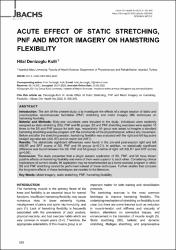| dc.description.abstract | Fasen, JM, O'Connor, AM, Schwartz, SL, Watson, JO, Plastaras, CT, Garvan, CW, Bulcao, C, Johnson, SC, and Akuthota, V. A randomized controlled trial of hamstring stretching: comparison of four techniques. J Strength Cond Res 23(2): 660-667, 2009-This study compared the efficacy of 4 different hamstring-stretching techniques. Flexibility can be achieved by a variety of stretching techniques, yet little research has been performed on the most effective method. The 2 basic types include active stretching, in which range of motion is increased through voluntary contraction, and passive stretching, in which range of motion is increased through external assistance. The 2 types of active stretching include neuromobilization and proprioceptive neuromuscular facilitation (PNF). Our study aims to determine which type of stretching technique is most effective in improving hamstring length. One hundred subjects between the ages of 21 and 57 were enrolled in the study. Intrarater reliability of hamstring length measurement was performed using 10 subjects. All 100 subjects were included in a randomized controlled trial of 5 different groups comparing different hamstring-stretching techniques. Outcome measures, including hamstring length and perceived level of hamstring tightness, were recorded on all subjects initially, at 4 weeks, and at 8 weeks. After 4 weeks of stretching, there was a statistically significant improvement in hamstring length (p < 0.05) using active stretches as compared with passive stretches. From weeks 4 through 8, hamstring length for the active stretching groups decreased. After 8 weeks of stretching, the straight leg raise (SLR) passive stretch group had the greatest improvement in hamstring length. There was no correlation between hamstring flexibility and age, initial tightness, or frequency of exercise per week. Improvement in hamstring flexibility was greatest for the SLR passive stretch. Also, using PNF in the 90/90 active stretch provided better knee range-of-motion improvements than the 90/90 passive methods did. | en_US |

















